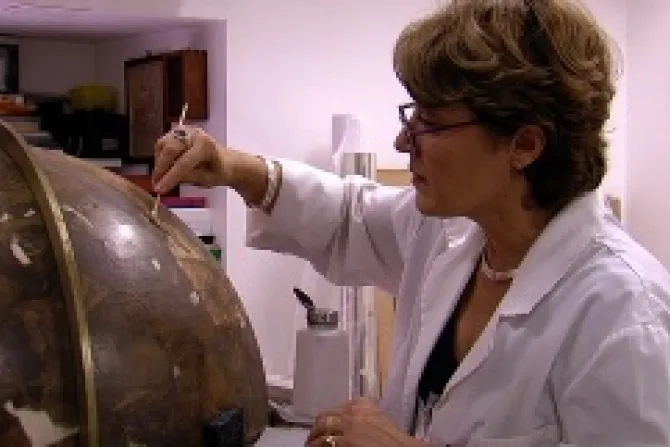Vatican City, Oct 28, 2013 / 07:21 am
Those in charge of the restoration of various types of artwork in the Vatican museums stress that the preservation of such treasures is necessary on both a historical and an educational level.
"I really feel that I remove the old varnish and I can see what is the state of engraving, the original state of engraving, but I do really step by step because we need to think what we do exactly because it is a big responsibility," restorer Chiara Fornaciari told CNA in an Oct. 21 interview.
Fornaciari is the Director of the Paper Restoration Laboratory, which facilitates the care of all paper works conserved in the Vatican Museums, with a particular emphasis on works of paper with color.
"I can feel the responsibility to do my work and I try day by day to think about this," Fornaciari said of a current project she is working on, "I like to see my work renew."
The Vatican Museums, founded by Pope Julius II, are an immense collection of different pieces of art located within Vatican City which have come into the Catholic Church's possession throughout the centuries.
Among the vast works within the museums are many of the most renowned classical sculptures and most significant masterpieces of Renaissance art in the world.
Deputy to the Director of the Vatican Museums for the Scholarly and Conservational Departments Arnold Nesselrath spoke with CNA on Oct. 21, stressing that without a restoration department, the Museums could not continue to exist in decent way.
"We have a restoration department for centuries," he noted, "First artists were trying to keep the works of art in a reasonable condition," but "when the approach became more scholarly," the museums funded the opening of several different departments in order to adhere to "modern standards" of restoration.
"Works of art always deteriorate by their nature, like everything deteriorates," Nesselrath noted, "so we need restoration departments to preserve the works."
"But restoration is not the only issue. What is important is of course the presentation of the works."
Because the art in the Museums are seen by so many, roughly 5 million people per year, Nesselrath that "if you want to present" the different pieces of art, "you have to present them in the best condition noted you can."
"All restoration is done in view of presentation because museums are an educational institution," he stressed.
Pieces within the museums that are chosen to be restored are done so primarily depending on the condition of the work, Nesselrath noted, and "restoration is only done on works that are damaged, that need maintenance, that have suffered from environmental influence."
Nesselrath is currently assisting in the restoration of the Borgia apartment, wall paintings done by the artist Pinturicchio for Pope Alexander VI, and various other projects concerning historic buildings within the Papal Palace.
Currently there are about 80 permanent employees working in the restoration labs, with close to 20 temporary employees, the number of which fluctuates depending on the projects undergoing restoration.
Both Fornaciari and Nesselrath gave special thanks the "Patrons of the Arts," who fund the restoration of the various historical and artistic pieces within the Museums by adopting certain projects either individually, or collectively as a chapter for a specific region.
"We are lucky to do this work," Fornaciari said of her job in the paper restoration lab, "we like this work."



